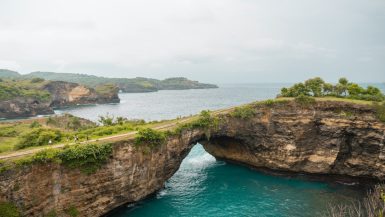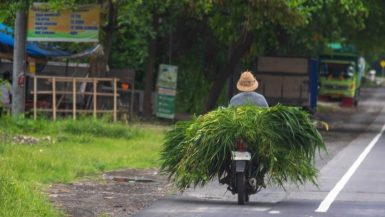
Indonesia, in case you didn’t know, is massive. With a land area of over 735,000 square miles (1.9m sq km) spread across 17,000 islands, it’s the world’s largest island country. Due to its position directly on the equator, Indonesia boasts a tropical climate; but also weathers five months of heavy monsoon rains every year.
This perfect balance of sun and rain supports an extremely diverse range of wildlife: in fact, Indonesia is classified as a “megadiverse country”, with over 200 endemic mammals. And while a holiday in the tropics is a great chance to study these mammals up close, there are some dangerous animals in Indonesia that you should definitely be aware of.
From the sea’s most toxic jellyfish to the world’s only living dragons, join us as we present our list of the 7 most dangerous animals you can find in Indonesia, and which ones amongst them are killers.
Sumatran Tiger
Latin Name: Panthera tigris sondaica | Human Deaths per year: 80 to 90 (estimated) | Fatal Weapons: sharp teeth and claws, fast over short distances | Where to Find Them: Sumatra and Bali | World Population: less than 900 | Conservation Status: critically endangered

Of the three species of tiger that once roamed Indonesia (collectively known as Sunda tigers), the only survivor is the Sumatran tiger, although its numbers are declining, with only about 450 individuals remaining in the wild. (There are also just over 400 Sumatran tigers in captivity: 100 in Indonesia and the rest in zoos. In the US, Sumatran tiger cubs are often sold for profit, as exposed by the Netflix documentary ‘Tiger King’).
Although known as one of the “big cats”, Sumatrans are the smallest of all the world’s tigers, weighing in at an average of 220 pounds. Recent research has suggested their diminutive size is the reason they’re still alive as a species, as they’ve been able to survive on smaller prey than other, now extinct, Indonesian tigers.
Despite their knack for survival, some experts believe that the Sumatran tiger will be extinct within the next 20 to 30 years. This is mainly due to poaching for animal parts — tiger bones are used in traditional Chinese medicine and fetch roughly $115 per kilo — and retaliatory killing of tigers that have attacked humans (ironically, a lot of those humans were poachers). The number of tigers killed in this way is totally disproportionate: as an example, between 2007 and 2010 only nine humans were killed by Sumatran tigers, yet twenty-five tigers were “euthanized” as a result.
Tigers are ambush predators, utilizing their superb camouflage to slowly and silently stalk their prey until they’re ready to pounce. Once committed to a kill, tigers will chase down their prey at up to 40 miles per hour. Fortunately for the intended prey, tigers can only achieve top speed in short bursts, so most attacks end with the tiger going hungry.
Sumatran and Bornean (or Pygmy) Elephants
Latin Name: Elephas maximus sumatrensis and E. max. borneensis | Human Deaths per year: at least 100 | Fatal Weapons: sharp tusks, sheer bulk | Where to Find Them: Sumatra and Borneo | World Population: approx 2,600 (Sumatran), and 1,500 (Bornean) | Conservation Status: critically endangered

Elephants might not seem like man-killers, but they are responsible for at least 100 human deaths per year, although some studies claim the figure is closer to 500. Regularly weighing in at over 5 tons, and armed with large, sharp tusks used for fighting other elephants, it’s not hard to see why these massive beasts pose a danger to humans.
Elephants can trace their roots back at least 55 million years, and historically there have been at least 300 different genera (types) of elephant. Today there are only two: the African (with the larger ears) and the Asian. The Sumatran Elephant, related to the Asian, is the largest mammal in Indonesia. Conversely, the world’s smallest elephant is the aptly named Pygmy, found in Borneo.
Sadly, in common with a lot of Indonesian wild animals, their habitat is under threat due to massive deforestation. As a result, elephants often find themselves wandering into human settlements. Known to stampede when frightened, elephants can trample homes, ruin crops, and maim, or even kill, humans. Many humans retaliate, by shooting at or sometimes poisoning the elephants, even though the animals are protected by Indonesian law. However, constant abuse by humans has created so-called “rogue elephants”, who see man as an enemy. These rogues regularly attack people with little or no provocation, leading to many needless, but inevitable, fatalities.
A further threat to humans is when a bull (male) elephant is in the musth phase: an annual event lasting between three and four months. During the musth (pronounced “must”), the male’s testosterone level is up to sixty times higher than normal, whilst he looks for a female mate. Whilst “in musth”, even the most placid elephants become highly aggressive, and many fatalities are recorded at this time.
Komodo Dragon
Latin Name: Varanus komodoensis | Human Deaths per year: less than 1 | Fatal Weapons: razor-sharp teeth and claws, anto-coagulate toxin | Where to Find Them: Komodo, Rinca, and Gilli Motang islands, and the Komodo National Park in Flores. | World Population: between 3,000 and 5,000 | Conservation Status: vulnerable

The Komodo Dragon is the largest living lizard in the world and the official animal of Indonesia. Growing up to 10 feet in length and up to 150 pounds in weight, they are apex predators and can kill in seconds. They will prey on anything that chances by, including water buffalo, wild pigs, and sometimes even their own young. And, occasionally, humans.
Although they’re not fire-breathing dragons (which don’t exist, despite what you may have seen in Game of Thrones!), their way of killing is still pretty gruesome. First, they stalk their prey, then they will charge at high speed and, quite literally, go for the jugular. Using their 60 razor-sharp teeth, they rip open the throat, inject an anti-coagulate toxin to hasten blood flow, then either wait for their victim to bleed to death or start devouring them immediately.
Although they are capable of killing and eating people, Komodo attacks on humans are extremely rare. At the Komodo National Park in Flores, historic reports show less than 30 attacks in the last 50 years, with only 5 of those resulting in a fatality. The last reported accident was in 2017 when a Singaporean tourist decided to take a picture of a feeding komodo, without consulting any of the Park Rangers. The obvious moral here is to never, ever, be alone with a group of Komodo Dragons: they might not be able to fly, but they can and will attack anything in their path.
Sea Wasp
Latin Name: Chironex fleckeri | Human Deaths per year: less than 1 (reported), 15-20 (estimated) | Fatal Weapons: extremely toxic venom | Where to Find Them: Shallow waters of the Indo-Pacific | World Population: impossible to determine | Conservation Status: no special status

Graceful, delicate, and strangely beautiful, the Sea Wasp is the largest species of box jellyfish and holds the title of most venomous marine animal in the world. If that wasn’t bad enough for the small fish and shrimp on which it usually preys, this “box jelly” is 95 percent comprised of water, making it all but transparent and therefore almost impossible to spot.
On top of that, Sea Wasps can actually swim, meaning they can propel themselves (at up to 4 knots) in a chosen direction rather than just drift wherever the currents take them. They also know where they’re going, due to having four true eyes. In other words, they can target, stalk, and then kill their prey, which gives them a predatory advantage over the 14 other species of jellyfish found in Indonesia.
To kill their prey, Sea Wasps are outfitted with up to 60 tentacles, each growing up to 10 feet long and lined with 500,000 ‘explosive’ cells. When they come into contact with the skin of their prey, these cells fire out tiny harpoon-shaped darts — known as nematocysts — which inject a cocktail of venom that simultaneously attacks skin cells, the nervous system, and the heart. Humans are as susceptible to this toxin as any other prey, and most victims go into shock and drown or die of heart failure before ever reaching the shore. This can happen in as little as two minutes, and the amount of venom in one Sea Wasp is said to be enough to kill 60 adult humans.
The number of actual deaths from sea wasp venom is uncertain. In Australia, which sees the highest concentration, there have only been 64 reported deaths since records began in 1883. However, most marine biologists believe that the real number is significantly higher, as many fatalities are misdiagnosed.
Saltwater Crocodile
Latin Name: Crocodylus porosus | Human Deaths per year: at least 1,000 worldwide (estimated) | Fatal Weapons: sharp teeth, incredibly powerful bite, death roll | Where to Find Them: Throughout Indonesia, particularly Sumatra | World Population: in excess of 400,000 | Conservation Status: least concern

Saltwater crocodiles, known affectionately as “salties”, are the world’s largest living reptiles. The males are the largest, although their dimensions vary greatly depending on age and other factors such as diet. Lengths of 12 to 19 feet are common, but according to the 2020 Guinness Book of Records, the largest saltie crocodile ever (in captivity) lived in the Philippines. His name was Lolong, and achieved a gargantuan length of 20 feet 3 inches (6.17 meters).
Saltwater crocs prefer to hide out in brackish mangrove swamps or river deltas, where they can stay submerged for up to an hour at a time, patiently awaiting their prey. Despite their name, saltwater crocs are excellent long-range swimmers in both salt and fresh water: an Australian individual once swam 370 miles in 25 days. So practically any river, stream or brook could be harboring a saltie, which is why you should never venture too close to the water’s edge anywhere in Indonesia, without a knowledgeable guide — in fact, that’s good advice wherever you are in the world!
Crocodiles, as most people know, have a super-powerful bite, but when expressed in numbers the actual bite pressure is staggering. To put it into perspective: when Mike Tyson bit off Evander Holyfield’s ear in 1997, the bite pressure was about 200 psi (pounds per square inch). A saltwater crocodile can apply a bite of 3,700 psi, which is almost 200 times stronger! This means a saltie’s bite is strong enough to crush any prey, up to and including any sharks that may stray into its territory.
In fact, saltwater crocodiles will attack anything and everything. Even swift-flying birds and bats will be snatched if they fly too close to the water’s surface — crocodiles can launch themselves almost vertically from a totally submerged position, as demonstrated in this awesome video. Their deadliest attack is reserved for larger prey. In a move known as the “death roll”, the croc will ambush the animal, drag it into the water, then roll its body underwater which disorients the doomed prey and often results in drowning.
Crocodiles do not necessarily set out to hunt humans, but a meal is a meal, and human fatalities are estimated at 1,000 per year. CrocBITE, the worldwide Crocodilian Attack Database, reports an average of 20 saltwater croc fatalities per year in Indonesia alone, although the actual number is almost certainly greater, as many attacks in small communities go unreported.
Venomous Snakes

Until recently, there were almost no records of snakebite cases in Indonesia, as most live in remote places where medical facilities are lacking. When they are bitten, victims tend to go to a local dukun (healer), who uses various traditional methods to try to “cure” them. Some survive, some don’t. In eastern Indonesia, taipans and brown snakes are the usual culprits, whereas snakebites in Java are likely to be from white-lipped or Malayan pit vipers.
A full list of Indonesian venomous snakes is too lengthy to include in this article, so instead, we’re focussing on three that we think are the most interesting: The Blue (or Malayan) Krait, the King Cobra and the Javan Spitting Cobra.
Blue Krait (Bungarus candidus)
The Blue Krait, also known as the Malayan Krait, is probably the most venomous snake to be found in Indonesia and across Asia and ranks as one of the deadliest snakes in the world. Preferring to stay hidden during the day, it hunts at night and most human bites occur when the snake is stepped on accidentally. Confusingly, the blue krait is not actually blue, which has lead to many cases of mistaken identity. If left untreated, between 50 and 70 percent of bites are fatal.
King Cobra (Ophiophagus hannah)
The King Cobra is the world’s longest venomous snake, measuring an average of 13 feet when fully mature, although the longest known individual measured over 19 feet. Although it’s typically shy and will avoid human confrontation whenever possible, the King Cobra is highly venomous and dangerous when agitated or provoked. In keeping with its “royal” status, the King Cobra preys mainly on other snakes, including other cobras and toxic snakes such as the blue krait described above.

Javan Spitting Cobra (Naja sputatrix)
Clad in a variety of colors and with no obvious markings, the Javan Spitting cobra is very difficult to distinguish from other snakes. Furthermore, they don’t ‘sit up’, which is what you’d expect from a cobra. As well as injecting its toxic venom through biting, the Javan Spitting Cobra can spray venom from its fangs for up to 6 feet. Although this “spitting” technique does not allow venom to enter the bloodstream, the most usual target is the face, and if this happens it’s vitally important not to rub your eyes, as this can lead to blindness.
Javan Rhinoceros
Latin Name: Rhinoceros sondaicus | Human Deaths per year: unknown | Fatal Weapons: powerful incisiors, sheer bulk | Where to Find Them: Java | World Population: 68 | Conservation Status: critically endangered

The Javan Rhino is the largest animal on the island of Java, and the second-largest in the whole of Indonesia (after the Sumatran Elephant). Lengthwise, Javan Rhinos top out at 13 feet, and they can weigh up to 5,000 pounds (which is well over 2 tons). Many years ago, the Javan Rhinoceros could be found wallowing in rainforests and grasslands across the whole of Southeast Asia, but now it’s possibly the rarest large mammal on Earth. Sadly, today only 68 individuals remain, all in the Ujung Kulon National Park at the western tip of Java.
Like its cousin the Indian rhinoceros, a male Javan rhino has a single horn, but it’s the smallest of all rhino horns with an average length of less than 8 inches. The female has no horn at all, which makes it unique amongst the rhinos of the world. Small horns are still valuable to poachers, with powdered horn sold to practitioners of Chinese traditional medicine for an incredible $35,000 per kilogram. A small group of Javan rhinos once lived in Vietnam, but the last of those was shot, for its horn, in April 2010.
Humans are the only known predators of adult Javan rhinos, and if a human gets too close, the Javan rhino becomes aggressive and will attack, thrusting upwards with its horn while stabbing with the powerful incisors in its lower jaw. Some of the larger males will also charge at a perceived threat, including SUVs which they mistake for other males due to their terrible eyesight (at 15 feet away or more, rhinos cannot distinguish between a human and a tree). And although there have been no recorded fatalities for many years, two tons of beast barrelling towards you at up to 30 miles per hour can still be considered dangerous, so inclusion in this list is definitely justified!
What is the most dangerous animal in Indonesia?
In terms of human fatalities per year, the most dangerous animal in Indonesia is the saltwater crocodile. It’s the world’s largest living reptile, and an opportunistic apex predator that will attack literally anything that it can eat. There aren’t many animals, or humans, that have managed to escape a hungry “saltie”, which kills using a bite force that’s second only to a great white shark. Worldwide, the saltwater croc is responsible for over 1,000 human deaths per year.
What is the most dangerous snake in Indonesia?
Technically, the most dangerous snake in Indonesia is the Eastern Brown Snake, which can be found in Papua New Guinea, half-owned by Indonesia. However, across the islands that make up “true” Indonesia, the most dangerous snake is the Blue Krait (aka Malayan Krait). It has an extremely potent neurotoxic venom that causes death in at least 50 percent of human bite victims, even with the administration of antivenin.
Are there dangerous spiders in Indonesia?
The short answer is no: there are no dangerous spiders in Indonesia. Although the country has its fair share of huge spiders, such as the Giant Golden Orb-Weaver and the panic-inducing Huntsman, there are no reports of spider bites ever being more than superficially harmful to humans in Indonesia. One local spider, called the Malabar, has an orange patch on the underside of the abdomen which has led some people to misidentify it as a deadly Black Widow. It’s roughly the right size, however, it’s totally harmless.


